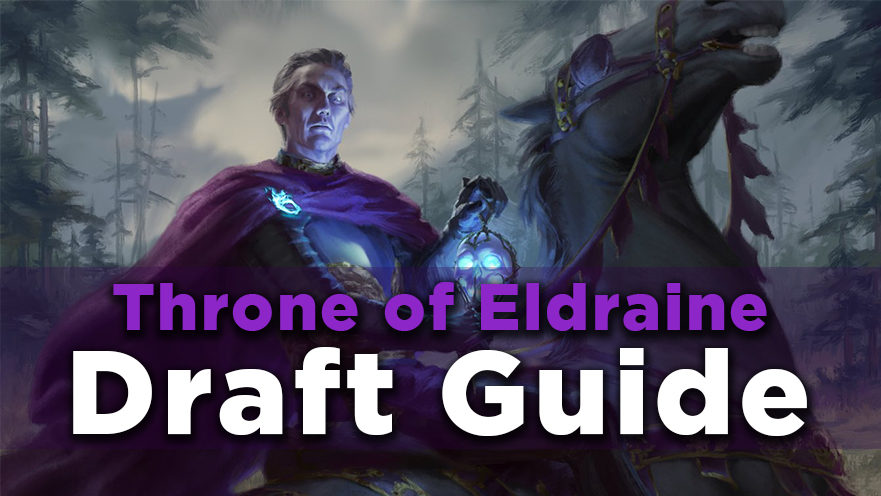It’s every Limited player’s favorite time of the year: time to learn a new draft format! Throne of Eldraine drafts are live on both MTG Arena and Magic Online, and Draft Weekend kicks off at local game stores tomorrow. If you have yet to draft Throne of Eldraine yourself – or if you’re still trying to wrap your head around the format – we’re here to offer our thoughts on the new cards.
Format Overview
Throne of Eldraine is one of the slower Limited formats we’ve seen recently. That stands to reason, given that the set’s three mechanics encourage longer, more drawn-out games.
- Food tokens pad players’ life totals significantly. If your opponent is all-in on the food theme, whittling their life total down to zero will be quite the task.
- The adventure mechanic gives players more spells to cast per game. Players who draft creatures with adventures may develop their boards more slowly so they can get maximum value out of their cards.
- Similarly, players may wait until they’re adamant enough to get bonus effects from their spells. If players choose to wait until they have three sources of a color before casting their more powerful spells, they’re less likely to “curve out” and progress the game at a usual clip.
These three mechanics may prolong games, but they also make Eldraine Limited a fun challenge. You’ll have to decide when it’s more important to use all the parts of your cards, and when it’s best to increase your board presence or set your opponent back. These added decisions make Throne of Eldraine a complex format, but they also give it added replay value. As you play, reflect on these complex decisions, and see what you can apply to future drafts.
Archetypes
Now that you have a feel for the format, let’s talk about the types of decks you’re likely to draft.
Like most Limited formats, Throne of Eldraine features several two-color archetypes. While there’s some overlap between these two-color pairs, we strongly encourage you to draft a two-color deck. Mana fixing is extremely limited in this format, so unless you’re determined to play that Planeswalker you opened, think twice before you splash a third color.
Black-Green Food
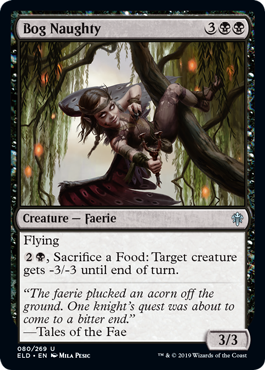
The Black-Green Food deck is one of the strongest decks you’ll find in Eldraine draft. This deck utilitizes food tokens to maintain a life total advantage and unlock powerful synergies. Savvy Hunter will give you fresh cards in exchange for a meal, while Bog Naughty will pelt opponents’ creatures with whatever you feed it. Your food deck may also have a creature-sacrifice or reanimation sub-theme, especially if you can pick up Witch’s Oven and Cauldron Familiar.
Blue-Black Graveyard

The Blue-Black deck isn’t a mill deck per se, but it’s the deck that cares the most about the graveyard. Several blue and black cards put cards into graveyards or go up in value if you’ve milled your opponent. This archetype doesn’t have as much inherent synergy as the others, and it may function best as a “flyers and removal” deck (a perennially strong strategy in draft). Lochmere Serpent is also one of the best rares in the set, so consider drafting this color combo if you pick one up early.
Blue-Red “Draw Two”

If you think “draw a card” are the three most powerful words ever printed in Magic, then this archetype is for you. The Blue-Red decks in Eldraine draft want to draw several cards each turn, and they can turn that card advantage into creature buffs and faerie tokens. You’ll only need to draw one additional card on your turn to gain an advantage, but if you need to draw cards on your opponent’s turn, look to Thrill of Possibility or Into the Story. This is one of the highest-synergy decks in the format, so make sure you have a good balance of enablers and pay-offs.
Red-Green “Non-Humans”
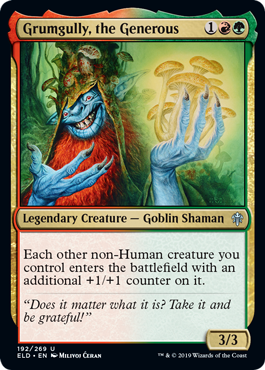
The Red-Green archetype is all about non-Human creatures. Grumgully, the Generous and Rampart Smasher are both compelling reasons to draft this deck, and they even work well together. Like the Red-Green “power 4 or greater matters” deck in War of the Spark, this deck’s goal is to keep the other decks in the format honest. If your opponent stumbles in the first few turns, this deck can capitalize quickly.
Blue-Green Ramp

Like the Blue-Black deck, Blue-Green Ramp doesn’t have a ton of synergy. The two Blue-Green uncommons give us a general sense of what this deck wants to do – ramp into large creatures and draw cards – but they don’t give us a definitive roadmap. However, there are plenty of strong cards available in these colors, including bomb rares like Oko, Questing Beast, and Wicked Wolf. There are also lots of non-Human creatures in this color pair, so you may be able to utilize cards like Keeper of Fables and Return of the Wildspeaker.
Green-White Adventure
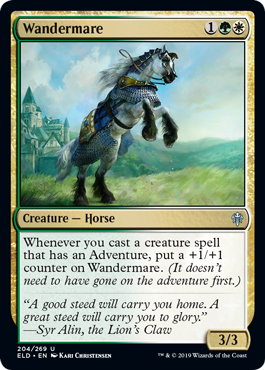
In contrast, the Green-White Adventure deck is extremely synergy-based. When drafting this strategy, you’ll want to load up on creatures with adventures, as well as pay-off cards. Wandermare is a strong uncommon for this strategy, but keep in mind that it doesn’t have evasion or generate card advantage. Mysterious Pathlighter and Edgewall Innkeeper will help round out your deck and keep you ahead of the curve.
Blue-White Artifacts and Enchantments
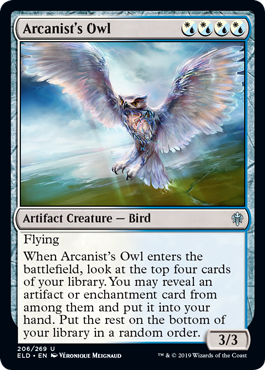
The Blue-White decks in the format are all about artifacts and enchantments. Fortunately, there’s plenty of good artifact- and enchantment-based removal in these colors, including Trapped in the Tower, Charmed Sleep, and Glass Casket. While this deck has some synergy, it’s not entirely dependent on artifacts and enchantments – they’re good to have, but this deck can also function as a flyers deck that plays artifacts and enchantments for added value. At the very least, Arcanist’s Owl is a 3/3 flyer for four mana, which is a pretty great rate.
Mardu Knights
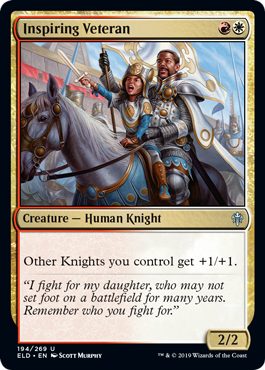
Finally, there are three Knights decks in the Eldraine Limited format. Like the Amass decks in War of the Spark Limited, the Knights decks all have slightly different flavors: Black-White wants to go wide, Red-White wants to buff its Knights with Inspiring Veteran, and Black-Red has the most access to equipment. There’s obviously some overlap here, and if you can pick up a copy of Tournament Grounds, you may be able to splash a third color in your Knights deck. These decks are at a bit of a disadvantage given the speed of the format, but like Red-Green Non-Humans, Knights can punish slower decks when they stumble.
Top Picks
So, we know all the archetypes in Throne of Eldraine draft. What incentives do we have to draft each one? Let’s go through some of the top cards at each rarity.
Top Commons
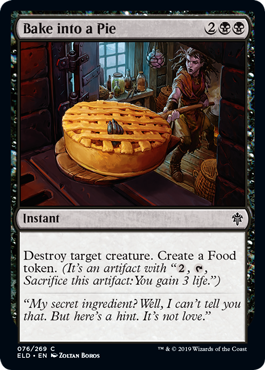
Like most draft formats, Eldraine’s best commons are its most efficient removal spells. Reave Soul, Trapped in the Tower, and Scorching Dragonfire will deal with most creatures for just two mana, and three mana isn’t a bad price for Charmed Sleep, either. Bake into a Pie costs four, but it’s the only unconditional removal spell we have, and it gives you a food token to boot. Outmuscle is the best removal spell you’ll find in green, but it has all the drawbacks we can expect from a “fight” card (ineffective unless you have a decent-sized creature in play).

Not surprisingly, the best common creatures either have efficient costs for their size (Fierce Witchstalker) and/or some form of evasion (Ardenvale Tactician). The commons in this set aren’t necessarily strong enough to pull you into a color, and you’ll want to find the cards that have the most synergy with your chosen strategy.
Top Uncommons
There are a few cycles of uncommons in Eldraine, so let’s go through them individually.
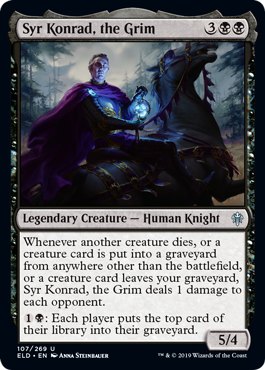
The “Syr” cycle: All five of the mono-colored uncommon Knights are strong, and you’ll gladly play all of them. Of them, however, Syr Konrad has the greatest potential to win the game on his own, and Syr Carah generates the most card advantage (and the most incidental damage).
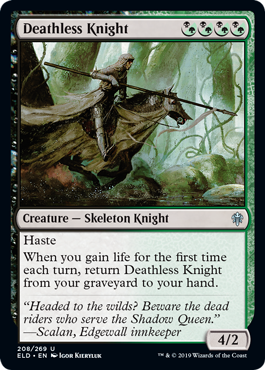
The “hybrid” cycle: These cards are all good role-players in their respective decks, but some are better in combat than others. Deathless Knight’s recursion ability makes it a great fit for a grindy Food deck, and Resolute Rider’s conditional indestructibility helps it win combat and blank removal spells. The raw stats on Rampart Smasher and Arcanist’s Owl are also fantastic. I’m a bit wary about Oakhame Ranger, which demands a lot of mana for relatively little power, and Elite Headhunter, a black and red creature whose damage output is easily negated by food tokens.
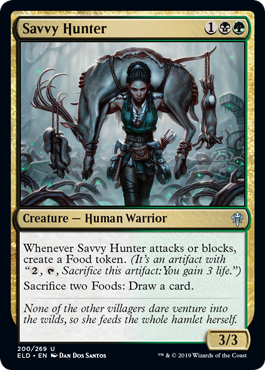
The gold cards: It’s hard to do an apples-to-apples comparison between these cards, because they all do such different things, but I tend to favor the ones with the lowest set-up costs. Improbable Alliance enables its own triggered ability, and Savvy Hunter is likely to attack or block at some point.
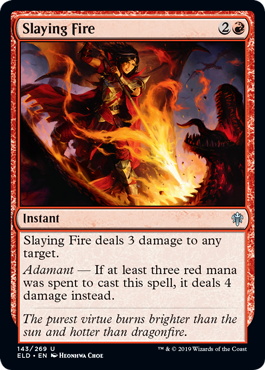
Additionally, be on the look-out for efficient uncommon removal spells (Epic Downfall, Slaying Fire) and creatures that can accrue card advantage (Keeper of Fables, Oakhame Adversary).
Your Quest Begins
I hope these tips will help you succeed at Throne of Eldraine draft, whether you’re playing online or at your local game store this weekend. If you have any lingering questions about Eldraine Limited, feel free to reach out to me on Twitter at @HallieMTG. And if you need more Throne of Eldraine booster boxes for your draft group, be sure to pick one up from CardKingdom.com.

Hallie served as Content Manager for CardKingdom.com and editor-in-chief of the Card Kingdom Blog from 2017-2022. Part tournament grinder, part content creator, Hallie is always looking for ways to improve her game and to share what she learns with others.

